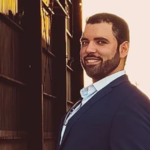Longitude Sound Bytes
Ep 44: Intentional introspection and creativity | Pedro Silva – by Jesse Annan van der Meulen (Listen)
I am Longitude fellow Jesse Annan van der Meulen from Rice University and today I’ll be presenting a sound byte by Pedro Silva, co-founder of Milkify.me, a start-up that offers a better way for parents to preserve the nutritional components of milk for infants. He’ll be speaking to us about creativity and the importance of, at times, letting go of old ways of thinking.

Pedro Silva, co-founder, Milkify.me :
Hello, my name is Pedro Silva, co-founder of Milkify.me, a startup whose mission is to break down barriers to breastfeeding. Today, I’m going to talk to you about creating space for creativity.
I graduated from Rice University, Martel, 2012, with a degree in economics, and worked in investment banking and energy private equity until I found something I was more passionate about. Now, as far as a career change goes, this is about as close as you can get to making a 90 degree turn into a new and unrelated field. So, it was quite scary at first. To deal with that fear, I reminded myself that in my finance career, I learned to deploy many analytical tools and ways of thinking really well in order to be successful. So I thought, “Surely, if I just apply those same old tools in a slightly different way, I can help lead Milkify to success.” How wrong I was! After months of what seemed like no progress, I realized I had fallen victim to the hammer problem.That is, if you’re a hammer, then every problem is going to look like a nail. And it turned out that many of the ways of thinking I had come to depend on in the world of structured finance, were not only not effective in the messy world of startups, they were actually holding me back from solving the actual problems that were in front of me. This realization really discouraged me at first; maybe I wasn’t the right person to work on our mission after all, unless that is, I could somehow stop treating every problem like I was a hammer banging on a loose screw. In other words, I decided I needed to look inwards and identify which specific parts of my thinking were getting in my own way. But how does one go about doing that? I found that the antidote to the hammer problem, at least for me, was creating space in the mind. The antidote started with building a mindfulness habit. That is, I became intentionally hyper-aware of my existing ways of thinking, and of my approaches to solving problems, the ones that defaulted to, and I started placing labels on them. Once I became hyper-aware of the thought patterns that my mind defaults to when pursuing goals or solving problems, it became possible for me to ask myself, “What if this is the wrong way to think about this problem, or what if, this is actually the exact opposite of the right way to think about this problem?” Now, I’m not saying that we should simply all throw away the skills and thinking tools that have served us so well in the past. The real lesson here is that the process of introspection itself, of noticing your thought patterns and questioning them, of inverting them, of temporarily letting them go, which is a habit that is absolutely worth building.
Well, what does any of this have to do with creativity? When you notice the thought patterns simply for what it is, and you allow it to just pass through you without judging it or believing in it right away, there’s empty space that opens in the mind. And here’s the kicker. In my experience, it’s in this intentionally created empty space, that my most creative ideas began to take form. It’s common wisdom that there are many things we can do to stimulate our own creativity. Go for a walk in nature, practice yoga or meditation, take a long shower or bath. I think what these approaches all have in common is that they facilitate a clearing of the mind. In other words, a clear mind unburdened by its own habitual thought patterns, is full of empty space in which creativity flourishes. So this process of intentional introspection is a really powerful way to unlock a lot of creative brainpower. By making this into a daily habit, those rare shower breakthroughs and other bursts of creative ideas became more frequent and more easily attainable for me. And I started solving problems, and we started doing better and better at Milkify. So when I look back on the biggest contributions I’ve made, I credit this process of intentionally creating space for creativity as one of the most important new habits I built.
So whether you’re trying to solve big problems or create something entirely new, whether it’s a work of art, a piece of writing, or an innovative company, remember that there will come a point when your default ways of thinking that served you so well in the past might start becoming the very things that hold you back from further progress. Building a habit of becoming aware of your thoughts, labeling them, and practicing letting go of them will create empty space in your mind. And in this empty mind space, unburdened by old ways of thinking, you might just be surprised by the creative new solutions that your mind dreams up. I hope you’ve enjoyed this sound byte. Thank you.

Jesse Annan van der Meulen, Longitude fellow, Rice University:
Thank you Pedro, for sharing your thoughts and experiences with us. The saying that “when all you have is a hammer, everything looks like a nail,” is something that I can relate to in my life, and I think that a lot of people do. I would think that the biggest challenge with this phenomenon is recognizing that we are that hammer. We often get so stuck in our daily habits that we don’t even realize that there are other ways to look at a problem and tackle it.
As Pedro pointed out, a telltale sign of this “hammer problem” could be that we’re feeling stuck. Whether that is related to our career, school, relationships, or anything else. But maybe this sensation of feeling stuck is an opportunity to let go, and to stop trying too hard for a second. Instead, we can slow down and create some space in the mind. While it can feel counterintuitive to slow down while all we want to do is go faster, as we slow down, there is an opportunity to mindfully investigate the thought patterns that have been running on autopilot. If we take a good look, we will most likely find a few things that are holding us back. Furthermore, the calmness and space that can emerge in the mind will only invite more creative ideas. And that might be just what we need.
We hope you enjoyed todays segment. Please feel free to share your thoughts over social media and in the comments, or write to us at podcast@longitude.site. We would love to hear from you.
Join us next time for more unique insights on Longitude Sound Bytes.
